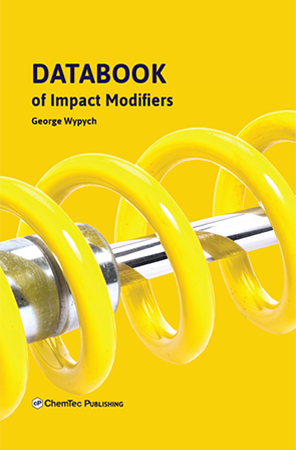This book is a must-have for manufacturers of impact modifiers, manufacturers of products containing impact modifiers, regulating bodies, academia, and research laboratories. The databook contains information, which is complete, timely, up-to-date, and useful in numerous fields of application and for thousands of manufacturers and products.
Impact modifiers are particularly recommended to improve mechanical and other properties, such as tensile, impact, flexural, stress whitening, stiffness, toughness, fracture behavior, etc., but they also influence adhesion, biodegradability, flammability, optical properties, thermal stability, and other properties of high-performance thermoplastic, polymer blends, and thermoset formulations.
The Databook of Impact Modifiers is more useful in combination with the Handbook of Impact Modifiers. Both books do not overlap but complement each other.
The information on over 300 impact modifiers is presented in individual tables for each product (either commercial or generic). The data are divided into 5 groups, including General Information, Physical Properties, Health & Safety, Ecological Properties, and Use & Performance. The following information is included in each Section if available in the source(s) of data.
General Information: Name, CAS #, EC #, Acronym, Antioxidant content, Biobased content, Butyl acrylate, Chemical category, Chemical/polymer name, Chlorine content, Common name, Common synonym, Composition, Core-Shell (CSR) dispersed type, CSR particle size, Diblock content, Empirical formula, EPA code, Epoxide equivalent weight, Ethylene content, Grafting degree, HSBC type, IUPAC name, Methyl acrylate, Molecular mass, Masterbatch, Mixture, Moisture content, Polymer structure, Polystyrene content, Product contents, Purity, RTECS number, Solvent system/content, Styrene/rubber ratio, and Total extractables.
Physical Properties: State, Odor, Color, Abrasion resistance, Acid #, Boiling point, Brittleness temperature, Bulk density, Cloud point, Coefficient of thermal expansion, Crystallinity, Crystallization temperature peak, Decomposition temperature, Density, Drying loss, Elongation at break, Flexural modulus, Flexural strength, Flexural stress at break, Flexural stress at yield, Gardner impact, Glass transition temperature, Gloss, Graves tear, Hardness Rockwell, Hardness Shore A, Hardness Shore D, Haze, Heat distortion temperature, Heat of combustion, Impact strength dart drop, Izod impact, Loss on ignition, MAH content, Melt flow rate, Melt viscosity, Melting/freezing point, Modulus 300%, Moisture absorption, Oxygen index LOI, Particle size, Particle size distribution, Pellets per gram, Permeability coefficient, pH, Refractive index, Relative permittivity, Ring and ball softening point, Set at break, Solubility in water and solvents, Specific gravity, Specific heat, Specific surface area, Spencer impact, Stiffness, Stress at yield, Surface hardness, Surface tension, Tear strength, Tensile elongation ultimate, Tensile impact strength, Tensile modulus, Tensile strain, Tensile strength, Thermal conductivity, Transmission visible, Vapor density, Vapor pressure, Vicat softening point, Viscosity, Viscosity index, Viscosity Mooney, Volatility, Volume resistivity, and Water vapor transmission rate.
Health & Safety: Autoignition temperature, Carcinogenicity, Dust explosion class, Eye irritation, Flash point, Flash point method, Flame characteristics, NFPA Health, NFPA Flammability, NFPA Reactivity, HMIS Health, HMIS Fire, HMIS Reactivity, HMIS Personal protection, Hazards, ICAO/IATA Class, IMDG Class, Mutagenicity, Rat oral LD50, Rabbit dermal LD50, Inhalation rat LC50, Skin irritation, and TLV - TWA 8h (ACGIH and OSHA)
Ecological Properties: Aquatic toxicity LC50 (Algae, Bluegill sunfish, Daphnia magna, Rainbow trout), Biodegradation probability, and Partition coefficient (log Koc).
Use & Performance: Manufacturer, Outstanding properties, General characteristics, Recommended for polymers, Recommended for products, Related end-markets Related functions, Processing methods, Concentrations used, Guideline for use, Process temperature, and Food contact.




